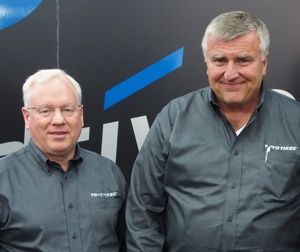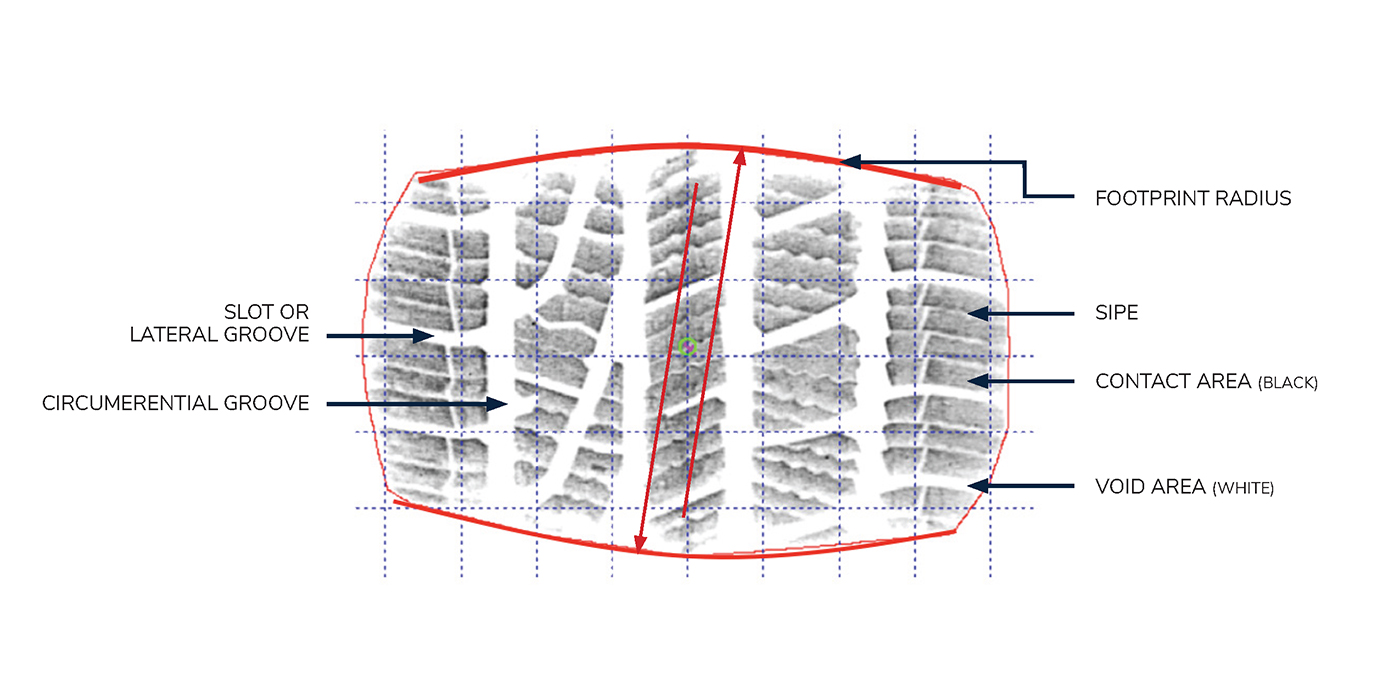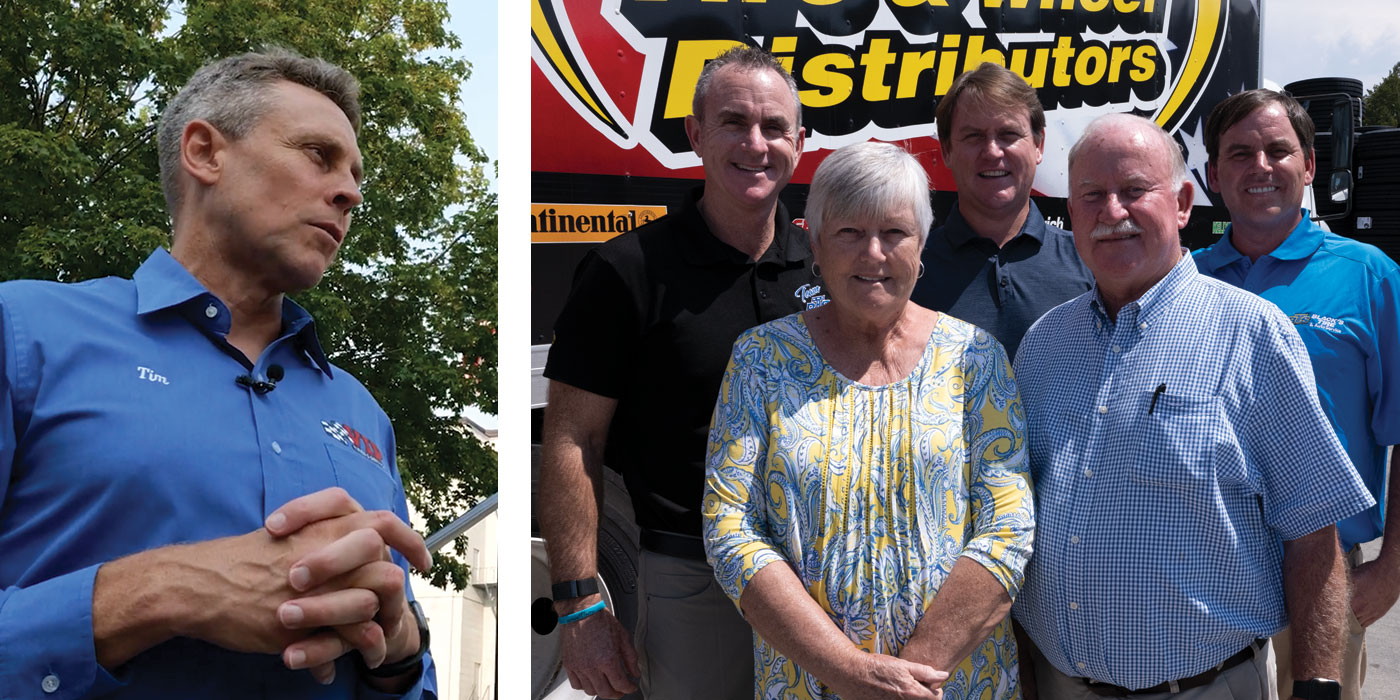At last month’s Mid-America Trucking Show in Louisville, Ky., Tire Review had the chance to sit down with Roy Bromfield, COO, and Randy Gaetz, vice president of sales for Toyo Tire U.S.A. Corp. The men shed some light on the tire industry as a whole, as well as Toyo’s goals and position in the market.
Bromfield joined Toyo in November 2012 after a career with Michelin North America and six years as president and CEO of Q Tires. Gaetz came to Toyo last October after stints as an executive with Del-Nat Tire Corp. and MNA.
TR: How satisfied are you with Toyo’s position with the market?
Bromfield: Never satisfied. Maybe the best way to put it is we make great products. Toyo really does. Excellent technology. And, Toyo should be a bigger part of the market. Basically, that’s Randy’s and my job. How do we take what we have that is good and make it into something else. I often will say inside the company is that Toyo is like an uncut diamond: it’s still a diamond, but it doesn’t get its value until you cut it and, shine it. So, we’re somewhat of an uncut diamond. There’s a lot here, and we just need to get it to market.

Gaetz: We know where we need to take this, and we know the steps along the way we have to go through to get there. So I think it’s fair to say that we’re satisfied with the progress we’re making, but we know we have a long way to go to get this where it needs to be.
Bromfield: Exactly. We are making very good progress. We had incredible growth in 2013. And 2014 is off to a great start. So, the things we’re putting in place are happening, on both sides of the business – consumer and commercial. Most of our growth last year came in consumer tires, and especially our light truck tires. In many of the sizes, we can’t make them fast enough.
TR: Talk about the challenges you’re facing trying to cut the diamond that is Toyo?
Bromfield: Well, I think if we first look at the commercial side, we have some excellent products and technologies that have been developed, but they haven’t really been brought to market in the U.S. On the product development side, our development team has worked very hard to make products applicable for the U.S. market. And now, we have a very strong portfolio and growing. We have a good product line that will get better over time. And strategically, we want to go through commercial servicing dealers, and to do that you have to have a good range of products appropriately priced. What we didn’t have before was a dedicated sales organization to the commercial business. In 2013, we made it a strategic objective to bring on a team and now everyone you see representing Toyo at this show is part of our commercial sales team. Now they have products that they can go to dealers with, and to work with those dealers to bring the products to market. Their mission now is to work with the commercial dealers to develop that business. And so, that’s an example where we have taken a step-by-step approach to build the market and build it appropriately and really establish a stronger foothold that will allow us to expand that.
TR: What are some of the specific goals that you have for the commercial business and then for the passenger side in the coming few years?
Bromfield: Well, on the commercial side, what I would say is that by 2020, we want to do two to three times the business we’re doing today. That’s a pretty lofty goal.
Gaetz: And have the vast majority of those tires sold through the commercial servicing dealer network.
Bromfield: So to double or triple that business and go to that distribution channel requires a lot. That’s where we see that going. All those steps will get us to that point. So, we have very defined goals for 2020 of where we want to be as a business in the commercial tire market. On the consumer side, it’s steep growth, but not quite as steep. And where are we looking to do that through? We’re looking to take the incredible success we’ve had with our off-road light truck tires, our Open Country series, and even broaden that more. If you look at the capacity that’s being added at our White, Ga., plant, we will add two million tires when our latest expansion is completed in 2015. Most of that new capacity will be Open Country series tires and certainly some of our bigger, ultra-high performance tires. Because we have a confidence in our growth cycle, the company has been adding capacity. We added a plant in Malaysia last year, and that’s providing us with more and more tires. We have certain products lined up, product lines we’ll produce in that plant. We’re adding capacity in Georgia, so now we can best match growth objectives with the available capacity to produce the types of tires we need.
Gaetz: The other challenge we have is there’s so much change in the distribution channels with acquisitions mounting every month. We task ourselves to figure out who will be the future winners, and then what models best fit what we want to do. You’ve got to make sure that the path you choose, and the people and the products and the culture of your company position the company where we need it to be.
Bromfield: I would say, on the commercial side of the business, there’s relative stability in the channels of distribution. On the consumer side, it’s continually evolving. And if you look at the acquisitions that are going on, then you think about the manufacturers that supply the acquired company and the acquiring company, and it can, overnight, change your mix and approach to the market.
Gaetz: I think for us, we need to be a big enough part of everybody’s business that it matters to them what we do together. If you’re not significant enough, nobody really cares that much. That’s not a good way to build your strategy going forward.
TR: So you’re not so much focusing on the larger distributors, but are you focusing on any distributors?
Bromfield: That’s a good question. If you come to this show and you go to SEMA, you see two different worlds. It’s the same thing inside the company. The commercial business is very different than the consumer. On the consumer side, yes, we do have regional retailers, and yes, there is an online commerce piece that you have to be aware of and see where that fits in their strategy. But there are also very large distributors, national and regional, and that’s the focus that we have and will have in the future. With the distributor, what we’re really looking for is support for an associate dealer program. We have one called the Driven Program. It’s our associate dealer program, and we want to use that program to grow our retail footprint. With the big and giant distributors, we want to work closely with them to promote our associate dealer program, our Driven Program, so we can increase that footprint.
Gaetz: But there are distributors that are owned by our competitors, and we can’t be naïve to that fact. But there are opportunities there, as well. Again, if you think about who’s going to be there for the future, who can be a sizable enough part of their business, that it means something. With all of these things, whether they’re independent or owned by a manufacturer, we need to evaluate if there is value there for Toyo.
Bromfield: Yeah, and more and more on the consumer side of the business, you have company-owned distribution. Distributors are either independent or owned by private equity. We might call them independent, but they’re really owned by private equity. So, what happens with that mix? If a private equity company wants to grow larger, they make acquisitions of the local or regional distributors, and we see that sort of consolidation continue to go on. Where I think Toyo traditionally went with smaller and medium-size local and regional retailers and distributors, now we’re looking at the reality of the market and saying, both on the retail and distributor side, where do we need to be positioned in the future? Who will be the winners? What distributors and dealers are going to be there five and 10 years from now? Let’s make sure we’re positioned with them. That could upset the applecart a little bit. Change is never easy, but we’re looking at that approach. I’m not at all saying we want to cut out the guys we have. We want to take good care of them. We have a strong, loyal dealer network, but we also have to look at the trends of the market, and you can’t grow by doing the same thing you did yesterday. We have to adapt to the marketplace, and that’s really a big piece of our strategy.
Gaetz: There’s a lot of complexity to it. There really is. And we’ve got to think about a lot of things to make sure we don’t make a mistake.
TR: You’ve touched on increasing capacity and aligning with different groups. What are some of the other ways that you’re going to do to meet your goals for the future?
Bromfield: Assuming capacity is in place and we can build the right things, then it’s really about developing the products, having the right marketing approach to attract dealers to sell them, and attracting consumers to walk into a store and ask for them. So, I’ll use our Open Country line as an example. You will continue to see product introductions there because we really see that as the lead product for Toyo. We’ve won the Baja 1000 and Baja 500 two years in a row. We have an incredible reputation in that marketplace. People walk through this booth and they love looking at those tires on these types of vehicles. So, we have a very dominant position there, and we want to continue to be dominant. But that growth is going to include not only the ability to produce more of these, but to have other products in that lineup that appeal to segments that either are white space today that we’re going to fill or are an area where we might be in between products. In that case, we need something that fits better. We’re also going to continue to push our ultra-high performance line. That’s a tougher and tougher market to compete in because of the Chinese manufacturers coming in at very low pricing, and they’re kind of pulling down and creating that compression in the marketplace. We’ll launch two consumer products this year, and one of them will be in an area where we’re okay today, but it’s a big segment and we need to have a new and improved product that, in this case, will be particularly interesting for our dealer network to sell.
TR: How far down the road is that coming out?
Bromfield: Late summer. We’ll have two launches in late summer.
TR: Overall for Toyo, are you focusing more energy into one market segment or across the board?
Bromfield: We’re a full-line supplier, but what defines us is the light-truck segment and the enthusiast segments. The market in this country is just not going away. It’s growing.
TR: And as far as your marketing, will there be a lot of focus on some of the motorsports Toyo is involved in, or will Toyo be in different places for the public?
Bromfield: In the light truck segment, we do a lot with off-road racing. We have several well-known racers, and as I mentioned, we’re in the Baja races. On the UHP side, we’re focused right now, really, in grassroots racing. We may step up the action there some. But the light-truck segment is the one where that’s really big and where we can make our biggest gain with the advantages that we have from a manufacturing technology and product technology side. What I would say is many other competitors have good marketing and good products, but our manufacturing technology especially matches these tires better than most or all of our competitors. Meaning as big and as luggy as that tire is, when it comes to the uniformity machine at the end of the manufacturing process, the tolerances are so tight. What does that mean? It means you could still put a big, tough-looking tire on your truck and it rides smooth. It doesn’t have vibration. It doesn’t get irregular wear. Customers love the look of it, and now it gives them a nice ride. Our manufacturing processes are a particular competitive advantage in the marketplace. But as I said, we’re a full-line supplier, so we do we need broadline tires and we need standard tires and touring-type tires, absolutely. And we continue to evolve those products and those lines.
TR: In looking at the entire tire industry, how do you think it’s doing with North America? Are you seeing growth overall? Let’s start with the passenger side and then commercial tires.
Gaetz: There’s no question, the lower tier, those tires coming from China, have grown a lot. For our business, we’re doing well, too. I can’t speak to say who’s losing, but something’s got to be giving somewhere.
Bromfield: Something’s got to be giving. We grew 19% last year. And it is absolutely true, lower tier Chinese products continue to grow. There are some companies are getting squeezed. I don’t know if it’s the guys above us, you know, the Big 3 or 4, that are getting squeezed, but we can’t have these growth rates and have this infusion of Chinese tires and no one gets squeezed.
Gaetz: But the industry is never going to be a rapid growth mode. You give some, you lose some. That’s what the tire business is, and I think you’ve got to work hard to do well at what you can and do the best with your dealers to help them grow. You have to make sure that you have a quality product that the dealers can make money on. Other companies have great tires, as well, but dealers complain that you can’t make any money selling brand X or brand Y.
Bromfield: Do we have any prognostications that the market’s going to have this big upsurge in 2014? No, I think we’re going to see, as most of the industry sees, we’re going to see growth. We’ll be healthier. That’s what we’re finding to start the year. It’s going to be a healthy year, but nothing extraordinary. In medium truck tires, the original equipment side is in one of its upsurges. That will be healthy for us on the commercial side because the big suppliers to the OE truck business will pull a lot of their capacity for those customers, and that will create some shortages that will more than likely become a good opportunity for us. We have the premium products that allow us to fill some of those voids and aid the development of our channels.
TR: Right now, what is the key in replacement tire sales?
Gaetz: I think the key is fill rate. There’s a demand out there, and every manufacturer struggles to get a fill rate that’s acceptable. I had a customer tell me the other day that he has six suppliers and each have fill rates in the high 50%-low 60% range, and he’s got to spend all day juggling the six, so that his fill rate to his customers is 95%. Our challenge is get our fill rate to an acceptable level, and try to take some of that burden off his plate.
Bromfield: We’re working on improving that fill rate. If we can have a strong fill rate, we will sell more because we become more a reliable supplier to that dealer or distributor, commercial or consumer.
TR: And how much of an impact will the capacity expansions have on fill rates?
Gaetz: Well, lst year with the sales ramp up, our supply of the tires increased 140%. The sales were up 175%. We know there’s going to be more tires, but are we to the point where the tires being supplied from that plant will meet the demand? I still think the demand’s going to be higher than we’re able to do.
Bromfield: It will help a tremendous amount. It’s painful, but we carry a lot of backorders, especially on our light-truck tires. When you add that much capacity, it should dramatically improve. We also have a sister brand, Nitto, which is looking for more capacity, as well.
Gaetz: But on the other hand, we have definite plans of distribution we want to add, but we’re held back because we can’t get tires. If we start to see that improve and we immediately go after this new distribution, then we’re right back in the same soup we were before we had the expansion of the plant.
Bromfield: You have to very, very carefully managing the mix. Right now in light-truck tires, we could grow a whole lot more rapidly, but we don’t have the capacity. So we’re trying to take the best care we can of our current customers, while at the same time laying some foundations for growth with some new ones.
TR: What plans do you have for the associate dealer program?
Gaetz: We ended 2013 with 763 associate dealers on the books. We want to have 1,000 by the end of 2014. We’re already there today. So, it’s going well, and again, I think the challenge there is to have better fill rates for these guys. But the reason it’s going so well is we have a consistent program now. There’s none of the monthly program changes, and that’s really resonated with the guys. We want to grow this as big as we can. There are other things we need to do, but we want to make sure we don’t go so fast that we screw it up. We’ve got to make sure we have enough tires to add enough and still be able to be a good supplier.
Bromfield: If you look at our advertising campaigns or sponsorships or marketing efforts, they’re also very well linked into that. So, when we have people winning big races, we’re always present, in enthusiast-type events, enthusiast magazines. We get a lot of things written up on our products by enthusiast magazines and the people that love those trucks. We sponsor the UFC, Ultimate Fighting Championship, and it’s an incredibly fast-growing sport. I didn’t think it was a good fit, but I was wrong. The demographic of the people that go to those things, they have money to spend, they’re passionate about sports. So, all these things match very well with the products we have and the channels we have and how we bring things to market. It creates an excitement, which is fun. You need broadline tires and touring tires to keep the plants going, but the excitement comes from the marketplace to your branding efforts in the tighter segments like light truck and UHP.














